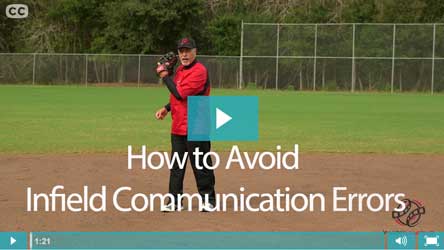Infield Communications
Probably the funniest bloopers in baseball involve collisions between players. While this is fun to laugh about when it happens to someone else, when it happens to you it is anything but funny. Not only is an infield collision extremely embarrassing and demoralizing, it’s also dangerous. Plenty of preventable injuries have occurred due to lack of communication, and the effect on the game overall can be nearly tragic. Dropping an easy out, getting mad at your teammates, feeling embarrassed and losing focus – these are what come of not communicating well on the field.
Pop-Up Communication
A pop-up is a gift from the batter, and every single pop-up should be caught. This is an easy out waiting to happen, so don’t screw it up. Dropping a pop-up is embarrassing, but not as embarrassing as dropping a pop-up because you and your teammate ran into each other. The best way to get used to talking on the field is to practice communication. In the infield, the shortstop is in charge. Each player has a range and radius of the field that is their priority. When the ball goes up in the air, each player needs to think about their role first and foremost. The shortstop will typically call it in order to avoid confusion and a costly mistake.
The catcher has the priority behind the plate. The first baseman has priority above him, in front of him, or to his left in foul territory. The third baseman has the mirror priority to the first baseman. The second baseman has priority in front of him or at him, as well as to his left, calling off the first baseman.
But the shortstop calls off everyone in the center of the infield, so the first, second, and third basemen have to listen for the call from the shortstop. The first baseman can be called off by the second baseman. If that all seems confusing, check out Bill Dancy’s video pop-up communication and priorities. (Members Access)
Once the ball is up in the air, it’s key that everyone on the field understands their role in the event of a pop-up. And then it’s time to communicate. The ball hits it’s peak and then the player with priority calls the ball three times, ‘I got it, I got it, I got it’. This ensures that players around them hear that the ball is called and that even if someone else attempted to call it, the player with priority has the final word.
Ensure that everyone in the infield knows how to communicate in the event of a pop-up and you’ll avoid collisions and their equally useless counterpart, the pop-up that hits the ground because two players called and then both backed off.
Communication Between Plays
The shortstop and second baseman need to be in constant communication, even before the play unfolds. This is another key piece of infield communications which not only helps to protect the infield but encourages the second baseman and the shortstop to get familiar with their communication strategy. If these two players can’t communicate, the infield is doomed.
So what do they talk about out there? And why do they hide their faces behind a glove so the batter can’t see? They’re deciding who’s going to cover the base when the pitch is thrown. There’s a shorthand to this which has been developed to make it easy for these two players to decide where they’ll be when the ball or runners come their way.
This can be fun, too, because it involves the two players making faces at each other. The shortstop is the one making the call, and in order to let the second baseman know that he’s going to take the plate, he’ll want to communicate ‘me’ to his teammate. Instead of saying or mouthing ‘me’, he’ll just keep his mouth closed. Meanwhile, the second baseman responds by making his mouth big and open, signaling that the base will be covered by ‘you’, in this case the shortstop. If that doesn’t make sense, or if you want to see Sam Perlozzo make funny faces at nobody, watch his video on infield communication(Members Access) between the second baseman and the short stop.
Of course, there’s a lot more communicating going on in the infield, as well as in the outfield. These are just a couple of the important pieces of information that need to be exchanged on a regular basis. Most importantly, players need to get in the habit of communicating with one another. Whether that means yelling out their intentions or simply making faces will depend on the situation. Good Luck!

